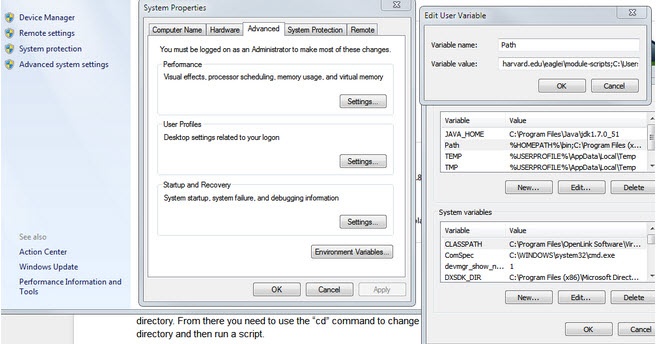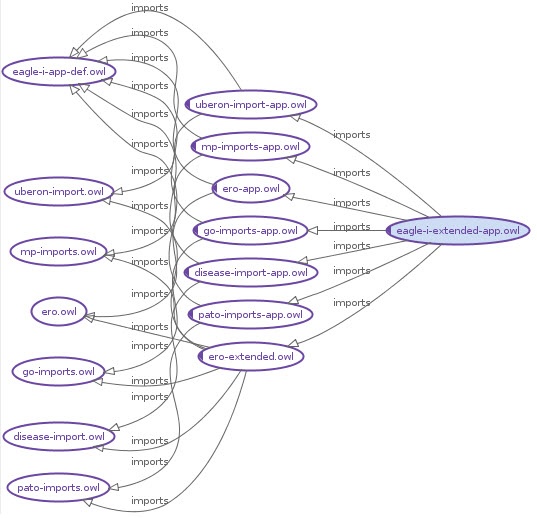Page History
...
If you are not in the module-scripts directory but would like to run a script without first changing to that directory, you have two options. Either type the full/relative path to the script file in the shell (for example, you might need to type “src/isf/module-scripts/ei-...”) or add the “module-scripts” directory to the Windows Path environment variable. Google for how to set Windows environment variables and you can adjust your “user” Path variable to include this directory. See the following image as an example. Google for instructions for doing this.
src/isf/ontology
This is an SVN external to the “VIVO-ISF Ontology” from GitHub (but the ontology directory only, not the root directory of the GitHub repository): https://github.com/vivo-isf/vivo-isf-ontology/trunk/src/ontology
...
This pulls in the “VIVO-ISF ontology” files that are needed to build the eagle-i ontology files. An SVN update done from the root of the eagle-i trunk checkout should pull in any ISF changes unless the external is pinned to a specific ISF commit. Currently the external is following the latest ISF commits.
src/isf/tools
This is an SVN external that follows the “eagle-i” Git branch from the following location: https://github.com/vivo-isf/tools/tree/eaglei/tools/owlcl
...
The eagle-i ontology is composed of a set of static application specific OWL files that are maintained manually, and a set of dynamically generated OWL files that are generated from the ISF ontology based on module configurations.
Static application ontology files
These files are located under the src/eagle-i/application directory when an SVN checkout is done. They have “app” in their name, are committed to SVN, and they have OWL imports that import the “non-app” ontology files that are generated in the src/eagle-i/public folder when the generation scripts or build tools are used.
These files are application files, meaning that their content is specific to the eagle-i application, and they should not contain any reusable “ontology” content. Any “ontology” content will be coming from the generated files.
To properly edit these files (add annotations, preferred labels, etc.), it is important that they have access to the latest generated ontology files based on the same SVN revision. To help with this, the tools should be used to generate the files based on the current SVN revision that is checked out. The additional benefit for running the build tool before viewing the application files is that Protege catalog files will be generated in the relevant directories to make sure that all imports are resolved locally instead of pulling them from the web.
Generated ontology files
These files, are generated with the tools based on the definition/configuration in each of their modules. They can be generated as needed with the provided tools.
The eagle-i SVN trunk tracks the ISF trunk in GitHub. Whenever an SVN update is done in the eagle-i trunk folder, the update may bring in new changes from the ISF external even if there are no eagle-i SVN changes. When there are new ISF changes and one of the module configurations is affected by this change (for example, a new technique term is added in ISF and a module configuration uses the technique hierarchy), either all of the module files or just the affected ones have to be regenerated by using the module scripts to see the changes in the generated ontology files.
The Bamboo build server is setup to track all three sources that affect the generated OWL files. It watches for changes in the eagle-i SVN, ISF GitHub repository, and the tools GitHub repository, and rebuilds the modules whenever there is a change. The Bamboo built modules -- along with the static files -- are packaged and uploaded to Nexus as a JAR file. The JAR file contains additional content beyond the generated OWL files.
| Info |
|---|
The latest builds, at the time of this writing, can be found packaged in the latest .jar file in the following directory: http://repo.eagle-i.net/nexus/content/repositories/snapshots/org/eagle-i/eagle-i-model-owl/999.0-SNAPSHOT |
The JAR file with the latest time stamp is the built eagle-i ontology. It can be unpacked as if it is a .zip file; the full eagle-i ontology is in this jar.
eagle-i ontology import structure
The following image shows the import structure of the eagle-i ontology:
In Protege 5, when all the files are loaded locally, looking at the import view should show that all imports are coming from local files:
In Protege 4, opening the “File -> Loaded ontology sources” should provide the same information. This same window in Protege 5 has become unusable.


